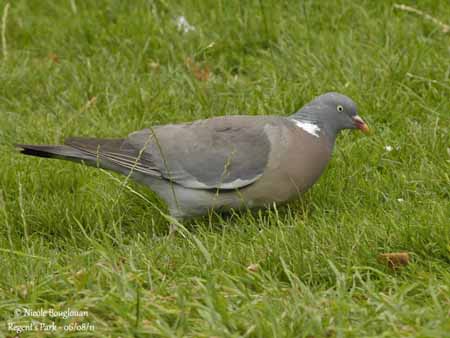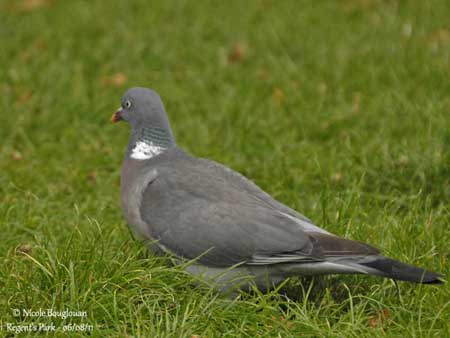
Fr: Pigeon ramier
All : Ringeltaube
Esp: Paloma Torcaz
Ital: Colombaccio
Nd: Houtduif
Sd: Ringduva
Photographers:
Jean Michel Fenerole
Photos d’Oiseaux du monde
Eugène Montocchio
Galerie Photos Nature
Nicole Bouglouan
PHOTOGRAPHIC RAMBLE
Texte de Nicole Bouglouan
Sources:
HANDBOOK OF THE BIRDS OF THE WORLD vol 4 by Josep del Hoyo-Andrew Elliott-Jordi Sargatal - Lynx Edicions - ISBN: 8487334229
PIGEONS AND DOVES by David Gibbs, Eustace Barnes and John Cox - Pica Press Sussex - ISBN: 1873403607
BirdLife International (BirdLife International)
Wikipedia, the free encyclopaedia
Common Wood Pigeon
Columba palumbus
Columbiforme Order – Columbidae Family
BIOMETRICS:
Length: 41-45 cm
Weight: 284-690 g
DESCRIPTION:
The Common Wood Pigeon is the largest of the European Columbidae species. This migratory bird is a famous gamebird during the migrations. They gather in large flocks in the harvested fields.
This large pigeon has bluish grey plumage overall, slightly duller on the wings. The primary flight feathers are black with whitish edges. We can see a white band on open wings and only a white stripe on the bend on closed wings. The tail is grey with white terminal band.
On the underparts, the breast is mauve-pink, turning creamy-white on belly. Flanks are pale grey.

The neck shows iridescent purple-pink and green feathers close to a white patch on the neck side.
The head is bluish grey. The bill is pinkish-red at base and yellow at tip, with white cere. The eyes are greenish white to pale golden, with narrow grey eye-ring. Legs and feet are reddish.

The female is similar but with smaller white neck patches and duller breast.
The juvenile is duller and paler with pale rusty breast. It lacks neck patches and iridescences and its eyes are darker, mostly grey with yellow tinge.

We can find six subspecies:
C.p. palumbus is found in Europe E to W Siberia and Iraq. It winters in N Africa. The British populations and C and W European birds are resident with some local movements.
C.p. maderensis (Madeira) and C.p. azorica (Azores) are duller with smaller neck patches.
C.p. excelsa (N Africa) is brighter.
C.p. iranica (Iran) has pale whitish to yellowish bill.
C.p. casiotis (Kazakhstan, Uzbekistan to N Afghanistan, N Pakistan, NW India and Nepal) has creamy-buff neck patches.
VOICE: SOUNDS BY XENO-CANTO
The Common Wood Pigeon can be heard almost all year round and mainly at dawn. It utters a far-carrying “croo COO coo cu cu” as advertising call. The first part “croo-croo” is a frequent variation.
HABITAT:
The Common Wood Pigeon is found in almost all natural habitats, and also in man-altered areas.
They favour well-wooded agricultural fields in lowlands and deciduous woodland edges, and usually avoid rocky and alpine habitats, treeless steppes and exposed coasts.
However, the N African races occur in mountainous areas and breed in wooded ravines.
This species is now common in urban areas, city parks and large avenues.
RANGE:
See above in “subspecies”.
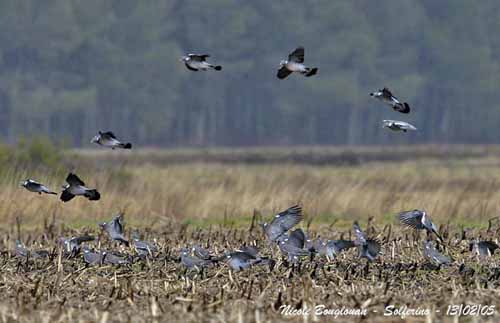
BEHAVIOUR:
The Common Wood Pigeon feeds both on the ground and in trees. It consumes plant matter and invertebrates, and is able to reach fruits in trees.
This species is gregarious and often occurs in large flocks outside the breeding season and during the migrations.

Early in the year, the male performs the typical flight display of Columbidae. It climbs rapidly and claps the wings, and then, it glides down in an arc on horizontal wings. This flight is repeated two or three times.
The bowing display close to the female enhances the neck patches and the green iridescences, while the tail is raised, fanned and closed alternatively. They also perform mutual preening.
All these displays are accompanied by calling.
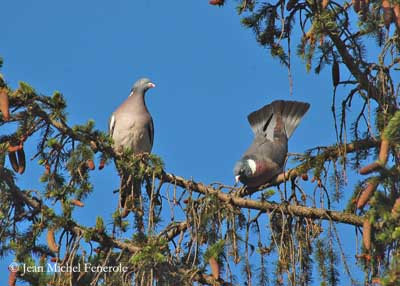

FLIGHT:
The Common Wood Pigeon is a good flier. The pigeon’s flight muscles are larger compared to those of other birds’ species. They fly swiftly and strongly, with powerful wing-beats.

REPRODUCTION:
The breeding season varies according to the range, but usually occurs from late February to early September.
The nest is placed between 1, 5 and 2, 5 metres above the ground in tree fork, on branch, in creeper in tree, and rarely on the ground even in thick vegetation.
It is made with twigs and lined with grasses and leaves, and finer twigs. It is often reused and may become bulkier after several broods.
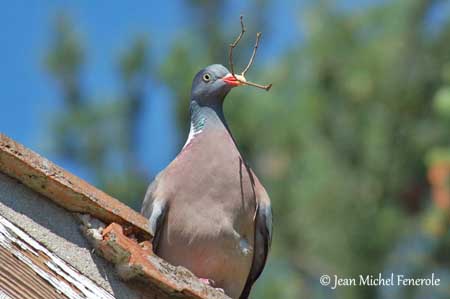
The female lays 1-3 white eggs. The incubation lasts 16-17 days by both parents. The young receive the same diet as adults with higher proportion of invertebrates and weed seeds. They fledge 28-29 days after hatching.

DIET:
The Common Wood Pigeon feeds on plant matter such as green leaves, buds, flowers, seeds, berries and root crops. It takes grain from wheat, barley, oats, maize and rape. It feeds on fruits of various plant species.
It also takes numerous invertebrates such as earthworms, beetles, pupae of Lepidoptera, spiders, slugs and snails.

PROTECTION / THREATS / STATUS:
The Common Wood Pigeon is common to very common, and even abundant.
The races “maderensis” and “azorica” become rare, and several declines may occur in eastern and southern parts of the range. But the populations are increasing in many countries due to exploitation by the birds of human-modified habitats.
